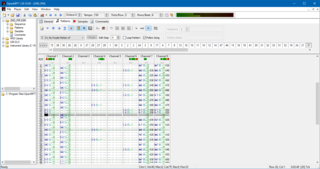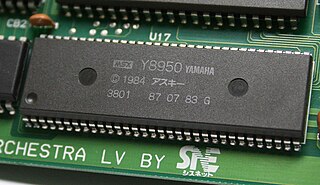
The Neo Geo, stylised as NEO•GEO and also written as NEOGEO, is a cartridge-based arcade system board and fourth-generation home video game console released on April 26, 1990, by Japanese game company SNK Corporation. It was the first system in SNK's Neo Geo family. The Neo Geo was marketed as the first 24-bit; its CPU is technically a 16/32-bit 68000-based system with an 8-bit Z80 coprocessor, while its GPU chipset has a 24-bit graphics data bus.

A sound card is an internal expansion card that provides input and output of audio signals to and from a computer under the control of computer programs. The term sound card is also applied to external audio interfaces used for professional audio applications.

A music tracker is a type of music sequencer software for creating music. The music is represented as discrete musical notes positioned in several channels at discrete chronological positions on a vertical timeline. A music tracker's user interface is usually number based. Notes, parameter changes, effects and other commands are entered with the keyboard into a grid of fixed time slots as codes consisting of letters, numbers and hexadecimal digits. Separate patterns have independent timelines; a complete song consists of a master list of repeated patterns.

The YM2612, a.k.a. OPN2, is a sound chip developed by Yamaha. It is a member of Yamaha's OPN family of FM synthesis chips, and is derived from the YM2203.
Video game music is the soundtrack that accompanies video games. Early video game music was once limited to sounds of early sound chips, such as programmable sound generator (PSG) or FM synthesis chips. These limitations have led to the style of music known as chiptune, and became the sound of the first video games.

The X68000 is a home computer created by Sharp Corporation. It was first released in 1987 and sold only in Japan. Gaming was a major use of the X68000, with custom sprite hardware and an 8-channel sound chip enabling ports of contemporaneous arcade video games.
The digital sound revolution refers to the widespread adoption of digital audio technology in the computer industry beginning in the 1980s.

The YM2413, a.k.a. OPLL, is a cost-reduced FM synthesis sound chip manufactured by Yamaha Corporation and based on their YM3812 (OPL2).
MDX is a Music Macro Language (MML) based format designed to be played on the X68000 series of computers. The music data is programmed then compiled into the MDX file. An optional PDX file containing PCM data may be present.

The AY-3-8910 is a 3-voice programmable sound generator (PSG) designed by General Instrument in 1978, initially for use with their 16-bit CP1610 or one of the PIC1650 series of 8-bit microcomputers. The AY-3-8910 and its variants were used in many arcade games—Konami's Gyruss contains five—and pinball machines as well as being the sound chip in the Intellivision and Vectrex video game consoles, and the Amstrad CPC, Oric-1, Colour Genie, Elektor TV Games Computer, MSX, and later ZX Spectrum home computers. It was also used in the Mockingboard and Cricket sound cards for the Apple II and the Speech/Sound Cartridge for the TRS-80 Color Computer.

The Yamaha YM2151, also known as OPM is an eight-channel, four-operator sound chip. It was Yamaha's first single-chip FM synthesis implementation, being created originally for some of the Yamaha DX series of keyboards. Yamaha also used it in some of their budget-priced electric pianos, such as the YPR-7, -8, and -9.
A programmable sound generator (PSG) is a sound chip that generates audio signals built from one or more basic waveforms, and often some kind of noise. PSGs use a relatively simple method of creating sound compared to other methods such as frequency modulation synthesis or pulse-code modulation.

The Yamaha Y8950 is a sound chip, produced in 1984. Essentially a Yamaha YM3526 with an ADPCM encoder/decoder added on, it is also known as MSX-Audio as it was designed for inclusion in an expansion cartridge for the MSX personal computer.

The YM2203, a.k.a. OPN, is a six channel sound chip developed by Yamaha. It was the progenitor of Yamaha's OPN family of FM synthesis chips used in many videogame and computer systems throughout the 1980s and early 1990s. The YM2203 itself was used in a variety of NEC computers, along with various arcade game machines.

YM2608, a.k.a. OPNA, is a sound chip developed by Yamaha. It's a member of Yamaha's OPN family of FM synthesis chips, and the successor to the YM2203. It was notably used in NEC's PC-8801/PC-9801 series computers.

The Yamaha YM2164 a.k.a.OPP, is an FM synthesis sound chip developed by Yamaha, an enhanced version of their YM2151 a.k.a. OPM. The OPP was used in various MIDI-based synthesizers by Yamaha - DX21, DX27, DX100, SFG-05, FB-01 - plus several licensed products: the IBM Music Feature Card and Korg's DS-8 and Korg 707.
The Yamaha YMF278B, also known as the OPL4, is a sound chip that incorporates both FM synthesis and sample-based synthesis by Yamaha.
The Yamaha YMZ280B, also known as PCMD8, is a sound chip produced by Yamaha Corporation. It is an eight-channel PCM/ADPCM sample-based synthesizer designed for use with video game machines, packaged in a 64-pin QFP.
The OPL series are a family of sound chips developed by Yamaha. The OPL series are low-cost sound chips providing FM synthesis for use in computing, music and video game applications.










